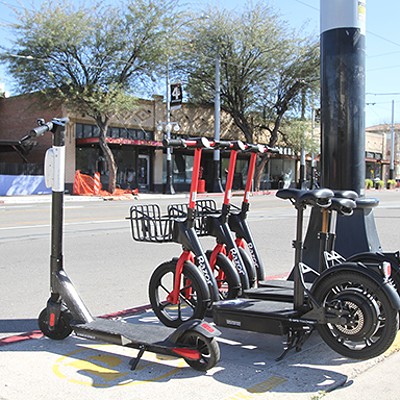Supporters hoped the change would calm traffic along Congress Street, which now serves a steady stream of cars, trucks and buses. With fewer cars, they hoped to create an ambience similar to nearby North Fourth Avenue.
But now the downtown crowd is worried about a consultant's suggestion that the City Council keep Congress Street and Broadway Boulevard as one-way streets.
Although the consulting outfit, Projects for Public Spaces, isn't due to deliver a final report until the end of February, planners have suggested in public workshops that one-way streets make more sense in downtown Tucson.
Hotel Congress owner Richard Oseran is out to squash that idea before the report even comes in. He complains that with at least 70 percent of the cars driving down Congress Street headed someplace other than downtown, the one-way street now functions as little more than an "on-ramp to Interstate 10."
"As long as that's the case," he says, "you cannot revitalize downtown. It ain't gonna happen."
Oseran is not alone in his desire to see two-way streets. In recent weeks, the board of the Transportation Enterprise Area Management (TEAM), which oversees parking and other downtown transportation issues, voted unanimously to support two-way streets, as did the board of the Tucson Downtown Alliance (with city members abstaining).
"We had bought into the notion that focusing on developing Congress' potential as an arts and entertainment district with historic character is our best strategic move, and that two-way is essential in developing the environment in which Congress can live up to that potential," says Donovan Durband, executive director of the Tucson Downtown Alliance. "Other values, like wider sidewalks, can wait, but we can't wait to slow down the relentless rush of traffic to I-10."
Durband says the Tucson Downtown Alliance is happy with "95 percent" of the consultant's draft, but remains adamantly opposed to keeping the one-way streets.
Projects for Public Spaces, which previously worked in Tucson drawing up the framework of the downtown Arts District in the late '80s, was brought in to consider alternatives for a master plan for Congress Street, including public art, redevelopment opportunities and other streetscape improvements.
The consultant has never before suggested a community stick with one-way streets, but Tucson's unique character led to the recommendation, according to Jim Glock, the city's transportation director.
Glock emphasizes that although the draft calls for one-way streets, it does recommend calming traffic by removing one of the current three lanes, cutting capacity by a third. The plan would allow for wider sidewalks and more parking, as well as open more development opportunities along Broadway Boulevard.
Glock says that from a strictly engineering viewpoint, one-way streets have advantages, but quickly adds that other interests have to be considered. His staff is already engineering the transition to two-way streets.
One major challenge: What's going to happen to the 40,000 vehicles that now use Congress Street and Broadway Boulevard daily?
Part of the long-term solution is giving drivers an alternative by completing the final mile of Barraza-Aviation Parkway, which will run parallel to the Union Pacific railroad tracks before emptying onto St. Mary's Road and the I-10 frontage road.
Glock estimates that project is likely to cost at least $75 to $95 million. Plus, planners are still trying to determine whether the new road will be on the north or south side of the railroad tracks.
Some of that work will get underway with the $15 million-plus construction of a new Fourth Avenue underpass, which will begin later this year once city officials can temporarily relocate the Greyhound Bus station at Congress Street and I-10.
The Fourth Avenue project, which includes rehabbing the current Fourth Avenue underpass as a pedestrian and bike passageway, will force Congress Street and Broadway Boulevard to become two-way streets.
The City Council has final say over the future of Congress Street and Broadway Boulevard, but Greg Shelko, the director of the Rio Nuevo downtown redevelopment project, insists there's no reason for anyone to get worked up over the possibility of a return to one-way roads.
Although city officials will take the recommendation "under advisement," Shelko doesn't anticipate asking the City Council to change the two-way policy.
"Since everybody's objective has been two-way, let's just accept this recommendation for what it is--a recommendation--and continue the engineering to get to the two-way solution that everybody wanted a few years ago," Shelko says.

















